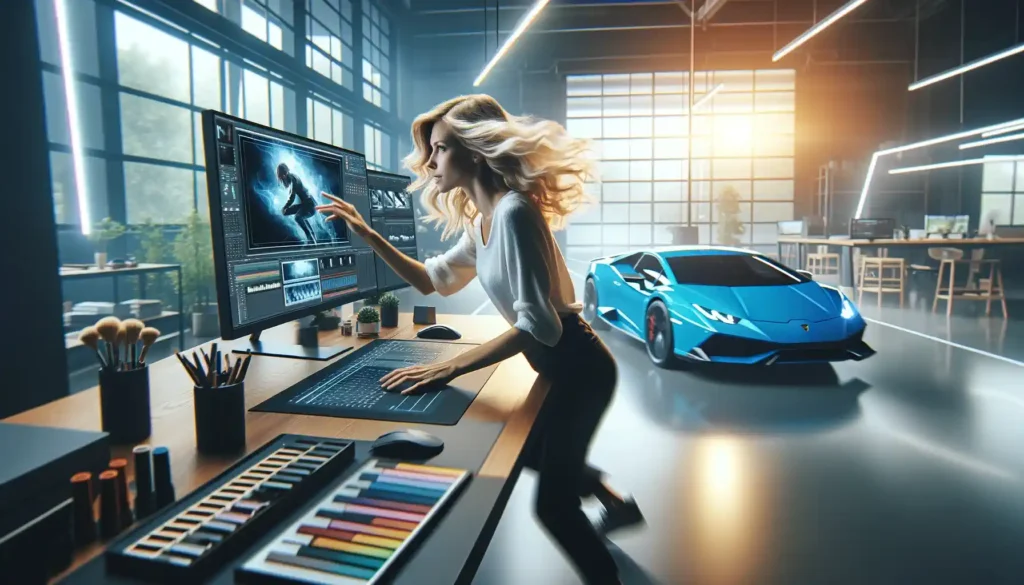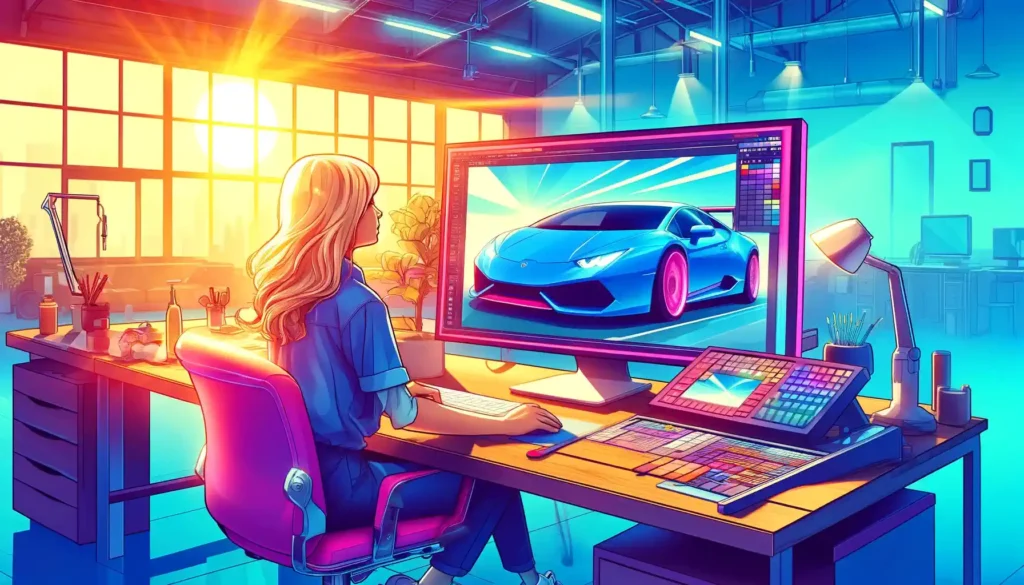Enhancing Sound with Unique Motion Graphics in Music Videos. In modern digital media, music videos have evolved beyond mere promotional tools to become immersive experiences. One of the most dynamic elements contributing to this transformation is the use of unique motion graphics.

How motion graphics enhance sound in music videos? Turning auditory experiences into captivating visual journeys that engage audiences in new and profound ways.
The Symbiosis of Sound and Visuals
Motion graphics provide a visual representation of sound, creating a symbiotic relationship between what we hear and what we see. This integration allows viewers to experience music through a dual sensory engagement. Intensifying the emotional and cognitive impact of the song. By synchronizing visuals to the beat, motion graphics can emphasize the rhythm and pace. Making the music more palpable and the beat more impactful.
Amplifying Emotional Resonance
Emotion is a core component of music, and motion graphics can amplify this emotional resonance visually. For instance, slow, sweeping graphics can enhance the melancholic tones of a ballad. While rapid, explosive visuals can complement the high energy of an upbeat track. Through color, movement, and style, motion graphics translate the emotional undertones of music into visual expressions. Enhancing the viewer’s emotional connection to the music.
Visualizing Complex Musical Elements
Motion graphics have the unique ability to visualize complex musical elements that may not be immediately apparent to the listener. Intricate beats, layered harmonies, and subtle sound effects can be highlighted through visual cues. Helping listeners appreciate the complexity of the music. This visual reinforcement can make complex compositions more accessible and enjoyable to a broader audience.
Narrative and Thematic Depth
Beyond enhancing sound, motion graphics can add narrative and thematic depth to music videos. They can create worlds that lyrics alone might only hint at, offering a deeper dive into the song’s thematic elements. For example, a song about loss and renewal might be paired with visuals that depict changing seasons. Using motion graphics to tell a story that complements the lyrics and enhances the song’s overall message.
Interactivity and Engagement
In an age where audience attention is fleeting, motion graphics in music videos can capture and maintain viewer engagement. Interactive elements, where visuals respond to user input or change over time. Create a dynamic viewing experience that encourages repeated views and deeper interaction with the music video. This not only extends the lifespan of the video but also deepens audience engagement with the music.
Technological Innovations
Advancements in technology have expanded the possibilities for integrating motion graphics with music. Real-time graphics rendering, virtual reality (VR), and augmented reality (AR) are pushing the boundaries of how motion graphics can interact with music. Offering immersive experiences that were previously unimaginable. These technologies allow creators to design visuals that are not only synchronized with music. But are also influenced by the viewer’s environment or actions, creating a personalized music video experience.
Case Studies of Successful Motion Graphics in Music Videos

The integration of unique motion graphics in music videos has revolutionized how audiences experience music visually. This article explores several successful case studies where motion graphics have not only complemented the musical content. But also set new standards in creative video production. Each case study highlights the innovative approach to motion graphics. Showing how they enhance storytelling, amplify emotional impact, and create a memorable visual identity for the music.
Case Study 1: Daft Punk – “One More Time”
Overview: Released in 2000, “One More Time” by Daft Punk is celebrated for its vibrant, animated music video. That features extensive use of motion graphics. The video, part of the “Interstellar 5555” series, tells a story. Using only music and animated visuals, without any spoken words.
Success Factors:
- Integrated Storytelling: The motion graphics blend seamlessly with the music. Advancing the narrative of aliens being kidnapped and turned into musicians on Earth.
- Visual Style: The video uses a distinctive, animated aesthetic that mimics the style of Japanese anime, which helps to create a strong visual identity that is instantly recognizable.
Impact: “One More Time” remains a seminal example of how motion graphics can narrate a compelling story through music alone, enhancing the song’s global appeal and iconic status.
Case Study 2: Kanye West – “Heartless”
Overview: Kanye West’s “Heartless” features a music video that uses rotoscoped animation to create fluid motion graphics, giving life to every beat and lyric with dramatic visuals.
Success Factors:
- Emotional Amplification: The use of stark, contrasting colors and exaggerated expressions in the animation highlights the song’s themes of pain and betrayal.
- Innovative Technique: Rotoscoping is a live-action footage that is traced to create animation. Providing a unique, painterly quality that made the video stand out in the visual landscape of music videos.
Impact: The video was not only a commercial success but also critically acclaimed for its artistic innovation, setting a high standard for emotional storytelling through motion graphics.
Case Study 3: Coldplay – “Up&Up”
Overview: Coldplay’s “Up&Up” features a surreal music video with imaginative motion graphics that combine disparate elements into a single cohesive visual stream, creating impossible scenarios like cars racing around Saturn’s rings or a diver jumping into a washing machine.
Success Factors:
- Surreal Imagery: The video uses motion graphics to craft visuals that are both surreal and visually mesmerizing, enhancing the song’s theme of limitless possibilities.
- Creative Composition: The seamless integration of various elements using motion graphics creates a dream-like quality that is both inspiring and thought-provoking.
Impact: The video was praised for its creativity and emotional depth. Winning several awards and further cementing Coldplay’s reputation for innovative music videos.
Case Study 4: OK Go – “The Writing’s On the Wall”
Overview: Known for their visually inventive videos, OK Go’s “The Writing’s On the Wall” uses a single continuous shot featuring a series of optical illusions with clever motion graphics to play with perception and perspective.
Success Factors:
- Interactive Engagement: The video keeps viewers engaged with its constant, playful visual tricks that perfectly sync with the music.
- One-shot Technique: The use of a single continuous take combined with real-time motion graphics creates a sense of immediacy and spontaneity.
Impact: This video is a testament to how motion graphics can be used to engage viewers, making them rethink their visual perceptions and encouraging multiple viewings.
Pulse of Graphics: Breathing Life into Beats with Visual Art Conclusion

These case studies showcase the diverse ways in which unique motion graphics can transform music videos into powerful tools for storytelling and emotional expression. From animated narratives and surreal visuals to innovative techniques and optical illusions, motion graphics continue to push the boundaries of how music is visualized, providing audiences with richer, more engaging experiences. As technology and creative ideas evolve, the role of motion graphics in music videos is set to become even more pivotal, offering endless possibilities for future music video productions.
Motion graphics transform music videos from simple song accompaniments to rich, multi-sensory experiences that enhance the sound and deepen the viewer’s connection to the music. By visually interpreting rhythms, emotions, and themes, motion graphics elevate the musical experience, making it more engaging, accessible, and memorable. As technology continues to evolve, the fusion of sound and visuals through motion graphics promises to play a pivotal role in the future of music video production, continuing to redefine how music is experienced in the digital age.